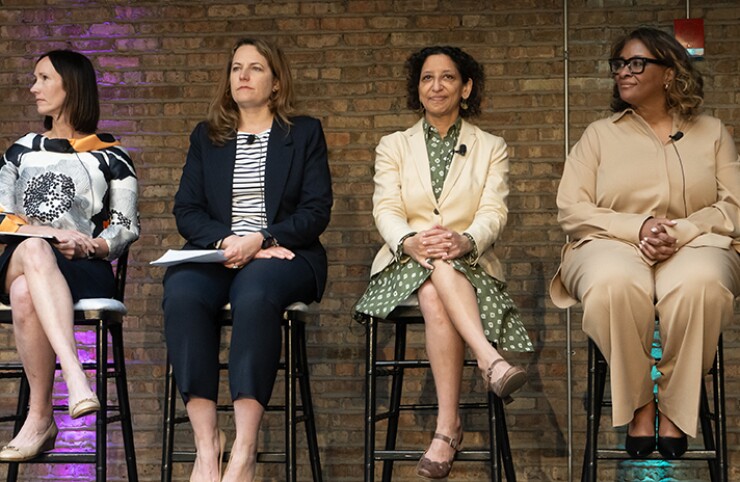The Inflation Reduction Act has paved the way for broader participation in affordable housing and a renewed focus by developers on sustainability, panelists at Baker Tilly’s 2024 DevelUP conference said this week.
One panelist called the 2022 law “the largest opportunity to build foundational generational wealth that you will experience,” and others praised the tax credit changes the law brought, even as they called for additional progress toward housing affordability and more inclusivity in development.
Illinois Gov. JB Pritzker’s administration sees “federal funding as a force multiplier,” said Kristin Richards, director of the Illinois Department of Commerce and Economic Opportunity.
Sonya Martin Photography
Althea Broughton, partner at Washington, D.C.-based Arnall Golden Gregory LLP, said her firm has been “seeing more complicated capital stacks” lately. Last year was a bit slow for affordable housing volume, she said, but the philanthropic community has stepped up and developers of color have increased.
The IRA’s Section 45 tax credit broadened the federal income tax benefits for renewable energy, specifically around
Don Bernards, a partner in Baker Tilly’s real estate group who moderated the panel, highlighted Section 48 of the IRA, which
He also sees potential in 501(c)(3) bonds. Other types of tax-exempt bonds may be difficult to get due to the cap, Bernards told The Bond Buyer, and many states “run out of” volume: “501(c)(3) bonds [have] some income restrictions … but they’re not really competitive, per se,” he said.
One client was recently able to obtain a rating from S&P Global Ratings, “which reduced [interest rates to] considerably below market.” Bernards said. Tax credits weren’t available. “Every deal is different, but that’s an alternative to look at,” he added.”
Catherine Evans, vice president of underwriting and credit for Freddie Mac multifamily housing, discussed small balance loans and Low Income Housing Tax Credit equity, where Freddie Mac is an investor: “We’re investing in those tax credits to help support the development or significant renovation of affordable properties,” she said.
She also emphasized the shift toward modular complete units, a construction method in which rooms are prebuilt in a factory using robotics. “[One] of the considerations we think about when we’re investing on the equity side [is] the financial capacity of the actual factory where it’s being developed,” she said. “Do they have a pipeline so they’ve got a consistency of work? Important for cash flow.”
Evans told The Bond Buyer Freddie Mac is “being cautious as we start to dip our toe into the water around investing in modular.”
In the affordable housing space, Tania Kadakia, founder of consulting and development firm Wrought Iron Partners, said, state agencies “really drive how the housing deals are put together,” and they’re bringing people into development who haven’t had access in the past.
But, she said, “to my knowledge, there is no woman- or Black- or Brown-owned LIHTC investor shop in the country.”
Andrea Ponsor, president and CEO of Stewards of Affordable Housing for the Future, addressed the challenges of layered capital stacks: “We are seeing, increasingly, more partnerships with emerging developers,” she said. “But … those partnerships are being fostered sometimes on transactions that are being asked to [fulfill] other policy objectives, as well. Which means you’re sometimes asked to do the most complex deal that is the most likely to run across gaps and operational challenges down the road.”

Sonya Martin Photography
Chris Meister, executive director of the Illinois Finance Authority, outlined “pots of money” — conduit bonds and state economic development loans, among others — available through his agency. He also pointed to the Commercial Property Assessed Clean Energy program’s open market initiative, a 501(c)(3) nonprofit. The initiative permits financing of up to 100% of all project and closing costs, according to
Joel Laubenstien, principal at Baker Tilly, said, the IRA “is like anything that’s ever come about on steroids. It really is unprecedented.”
There are over 70 separate tax credits in the IRA, he noted. And there’s the option to transfer credits: if owners don’t have tax liability or taxable income, they can sell tax credits to someone else.
“What this did is twofold,” Laubenstein told The Bond Buyer. “It took the old credits and reinstated them to their former glory; it added all these bonus criteria credits, what I call the carrots and the sticks … and then it expanded into a lot of new opportunities, technology like pump storage … Electric vehicle charging and electric vehicles were also big winners in the act. Hydrogen was another big winner.”
AJ Patton, CEO of 548 Enterprise, said the federal government has created once-in-a-generation incentives: “Direct transfer changed the game.”
He added that every state has someone like Meister working to make funding available.
“Every state has different incentives, there are different levels of commitment to energy efficiency,” Patton told The Bond Buyer. “Obviously, Illinois is one of the leaders … Michigan has done a spectacular job coming to the table, creating an incentive package and inspiring the next generation … The mayor of St. Louis, Tishaura Jones, does a great job. There’s a new generation of political leaders that have embraced the economic impact of this.”
Carla Walker Miller, founder and CEO of Walker Miller Energy Services, called the IRA “the largest opportunity to build foundational generational wealth that you will experience.” She said it atones for disparities in which neighborhoods got the “dirty infrastructure.”
“You’re either in the clean energy economy, or the clean energy economy is going to run over you,” she said.
